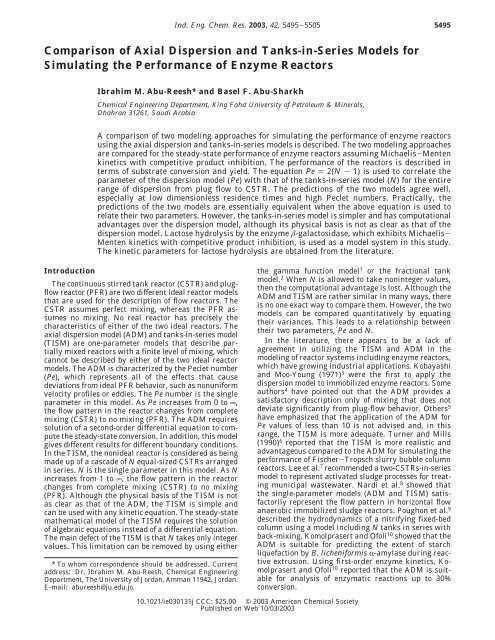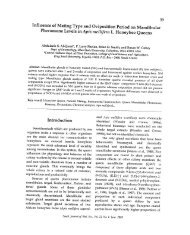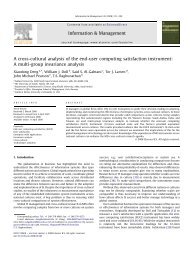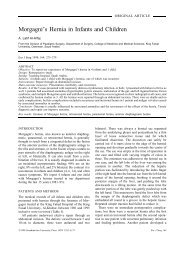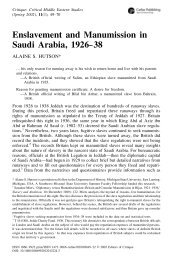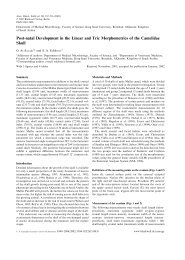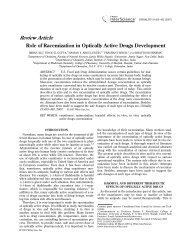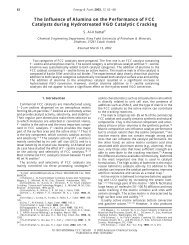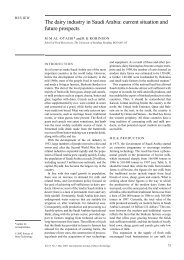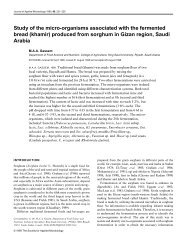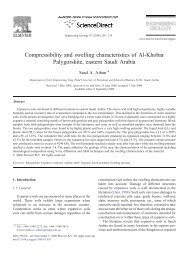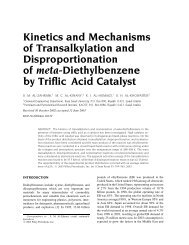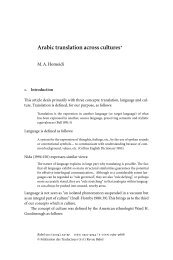Comparison of Axial Dispersion and Tanks-in-Series Models for ...
Comparison of Axial Dispersion and Tanks-in-Series Models for ...
Comparison of Axial Dispersion and Tanks-in-Series Models for ...
You also want an ePaper? Increase the reach of your titles
YUMPU automatically turns print PDFs into web optimized ePapers that Google loves.
<strong>Comparison</strong> <strong>of</strong> <strong>Axial</strong> <strong>Dispersion</strong> <strong>and</strong> <strong>Tanks</strong>-<strong>in</strong>-<strong>Series</strong> <strong>Models</strong> <strong>for</strong><br />
Simulat<strong>in</strong>g the Per<strong>for</strong>mance <strong>of</strong> Enzyme Reactors<br />
Ibrahim M. Abu-Reesh* <strong>and</strong> Basel F. Abu-Sharkh<br />
Chemical Eng<strong>in</strong>eer<strong>in</strong>g Department, K<strong>in</strong>g Fahd University <strong>of</strong> Petroleum & M<strong>in</strong>erals,<br />
Dhahran 31261, Saudi Arabia<br />
A comparison <strong>of</strong> two model<strong>in</strong>g approaches <strong>for</strong> simulat<strong>in</strong>g the per<strong>for</strong>mance <strong>of</strong> enzyme reactors<br />
us<strong>in</strong>g the axial dispersion <strong>and</strong> tanks-<strong>in</strong>-series models is described. The two model<strong>in</strong>g approaches<br />
are compared <strong>for</strong> the steady-state per<strong>for</strong>mance <strong>of</strong> enzyme reactors assum<strong>in</strong>g Michaelis-Menten<br />
k<strong>in</strong>etics with competitive product <strong>in</strong>hibition. The per<strong>for</strong>mance <strong>of</strong> the reactors is described <strong>in</strong><br />
terms <strong>of</strong> substrate conversion <strong>and</strong> yield. The equation Pe ) 2(N - 1) is used to correlate the<br />
parameter <strong>of</strong> the dispersion model (Pe) with that <strong>of</strong> the tanks-<strong>in</strong>-series model (N) <strong>for</strong> the entire<br />
range <strong>of</strong> dispersion from plug flow to CSTR. The predictions <strong>of</strong> the two models agree well,<br />
especially at low dimensionless residence times <strong>and</strong> high Peclet numbers. Practically, the<br />
predictions <strong>of</strong> the two models are essentially equivalent when the above equation is used to<br />
relate their two parameters. However, the tanks-<strong>in</strong>-series model is simpler <strong>and</strong> has computational<br />
advantages over the dispersion model, although its physical basis is not as clear as that <strong>of</strong> the<br />
dispersion model. Lactose hydrolysis by the enzyme -galactosidase, which exhibits Michaelis-<br />
Menten k<strong>in</strong>etics with competitive product <strong>in</strong>hibition, is used as a model system <strong>in</strong> this study.<br />
The k<strong>in</strong>etic parameters <strong>for</strong> lactose hydrolysis are obta<strong>in</strong>ed from the literature.<br />
Introduction<br />
The cont<strong>in</strong>uous stirred tank reactor (CSTR) <strong>and</strong> plugflow<br />
reactor (PFR) are two different ideal reactor models<br />
that are used <strong>for</strong> the description <strong>of</strong> flow reactors. The<br />
CSTR assumes perfect mix<strong>in</strong>g, whereas the PFR assumes<br />
no mix<strong>in</strong>g. No real reactor has precisely the<br />
characteristics <strong>of</strong> either <strong>of</strong> the two ideal reactors. The<br />
axial dispersion model (ADM) <strong>and</strong> tanks-<strong>in</strong>-series model<br />
(TISM) are one-parameter models that describe partially<br />
mixed reactors with a f<strong>in</strong>ite level <strong>of</strong> mix<strong>in</strong>g, which<br />
cannot be described by either <strong>of</strong> the two ideal reactor<br />
models. The ADM is characterized by the Peclet number<br />
(Pe), which represents all <strong>of</strong> the effects that cause<br />
deviations from ideal PFR behavior, such as nonuni<strong>for</strong>m<br />
velocity pr<strong>of</strong>iles or eddies. The Pe number is the s<strong>in</strong>gle<br />
parameter <strong>in</strong> this model. As Pe <strong>in</strong>creases from 0 to ∞,<br />
the flow pattern <strong>in</strong> the reactor changes from complete<br />
mix<strong>in</strong>g (CSTR) to no mix<strong>in</strong>g (PFR). The ADM requires<br />
solution <strong>of</strong> a second-order differential equation to compute<br />
the steady-state conversion. In addition, this model<br />
gives different results <strong>for</strong> different boundary conditions.<br />
In the TISM, the nonideal reactor is considered as be<strong>in</strong>g<br />
made up <strong>of</strong> a cascade <strong>of</strong> N equal-sized CSTRs arranged<br />
<strong>in</strong> series. N is the s<strong>in</strong>gle parameter <strong>in</strong> this model. As N<br />
<strong>in</strong>creases from 1 to ∞, the flow pattern <strong>in</strong> the reactor<br />
changes from complete mix<strong>in</strong>g (CSTR) to no mix<strong>in</strong>g<br />
(PFR). Although the physical basis <strong>of</strong> the TISM is not<br />
as clear as that <strong>of</strong> the ADM, the TISM is simple <strong>and</strong><br />
can be used with any k<strong>in</strong>etic equation. The steady-state<br />
mathematical model <strong>of</strong> the TISM requires the solution<br />
<strong>of</strong> algebraic equations <strong>in</strong>stead <strong>of</strong> a differential equation.<br />
The ma<strong>in</strong> defect <strong>of</strong> the TISM is that N takes only <strong>in</strong>teger<br />
values. This limitation can be removed by us<strong>in</strong>g either<br />
* To whom correspondence should be addressed. Current<br />
address: Dr. Ibrahim M. Abu-Reesh, Chemical Eng<strong>in</strong>eer<strong>in</strong>g<br />
Department, The University <strong>of</strong> Jordan, Amman 11942, Jordan.<br />
E-mail: abureesh@ju.edu.jo.<br />
Ind. Eng. Chem. Res. 2003, 42, 5495-5505<br />
5495<br />
the gamma function model 1 or the fractional tank<br />
model. 2 When N is allowed to take non<strong>in</strong>teger values,<br />
then the computational advantage is lost. Although the<br />
ADM <strong>and</strong> TISM are rather similar <strong>in</strong> many ways, there<br />
is no one exact way to compare them. However, the two<br />
models can be compared quantitatively by equat<strong>in</strong>g<br />
their variances. This leads to a relationship between<br />
their two parameters, Pe <strong>and</strong> N.<br />
In the literature, there appears to be a lack <strong>of</strong><br />
agreement <strong>in</strong> utiliz<strong>in</strong>g the TISM <strong>and</strong> ADM <strong>in</strong> the<br />
model<strong>in</strong>g <strong>of</strong> reactor systems <strong>in</strong>clud<strong>in</strong>g enzyme reactors,<br />
which have grow<strong>in</strong>g <strong>in</strong>dustrial applications. Kobayashi<br />
<strong>and</strong> Moo-Young (1971) 3 were the first to apply the<br />
dispersion model to immobilized enzyme reactors. Some<br />
authors 4 have po<strong>in</strong>ted out that the ADM provides a<br />
satisfactory description only <strong>of</strong> mix<strong>in</strong>g that does not<br />
deviate significantly from plug-flow behavior. Others 5<br />
have emphasized that the application <strong>of</strong> the ADM <strong>for</strong><br />
Pe values <strong>of</strong> less than 10 is not advised <strong>and</strong>, <strong>in</strong> this<br />
range, the TISM is more adequate. Turner <strong>and</strong> Mills<br />
(1990) 6 reported that the TISM is more realistic <strong>and</strong><br />
advantageous compared to the ADM <strong>for</strong> simulat<strong>in</strong>g the<br />
per<strong>for</strong>mance <strong>of</strong> Fischer-Tropsch slurry bubble column<br />
reactors. Lee et al. 7 recommended a two-CSTRs-<strong>in</strong>-series<br />
model to represent activated sludge processes <strong>for</strong> treat<strong>in</strong>g<br />
municipal wastewater. Nardi et al. 8 showed that<br />
the s<strong>in</strong>gle-parameter models (ADM <strong>and</strong> TISM) satisfactorily<br />
represent the flow pattern <strong>in</strong> horizontal flow<br />
anaerobic immobilized sludge reactors. Poughon et al. 9<br />
described the hydrodynamics <strong>of</strong> a nitrify<strong>in</strong>g fixed-bed<br />
column us<strong>in</strong>g a model <strong>in</strong>clud<strong>in</strong>g N tanks <strong>in</strong> series with<br />
back-mix<strong>in</strong>g. Komolprasert <strong>and</strong> Ofoli 10 showed that the<br />
ADM is suitable <strong>for</strong> predict<strong>in</strong>g the extent <strong>of</strong> starch<br />
liquefaction by B. licheni<strong>for</strong>mis R-amylase dur<strong>in</strong>g reactive<br />
extrusion. Us<strong>in</strong>g first-order enzyme k<strong>in</strong>etics, Komolprasert<br />
<strong>and</strong> Ofoli 10 reported that the ADM is suitable<br />
<strong>for</strong> analysis <strong>of</strong> enzymatic reactions up to 30%<br />
conversion.<br />
10.1021/ie030131j CCC: $25.00 © 2003 American Chemical Society<br />
Published on Web 10/03/2003
5496 Ind. Eng. Chem. Res., Vol. 42, No. 22, 2003<br />
Us<strong>in</strong>g the equation Pe ) 2(N - 1) to relate the<br />
parameters <strong>of</strong> the two models, Elgeti 11 found good<br />
agreement between a pipe flow reactor <strong>and</strong> a series <strong>of</strong><br />
ideally mixed reactors <strong>for</strong> first-order, second-order, <strong>and</strong><br />
first-order successive reactions. Elgeti 11 showed that the<br />
equation Pe ) 2(N - 1) has a good theoretical basis.<br />
Others 12,13 also have used the same equation. Van<br />
Hasselt et al. 14 showed that, <strong>for</strong> the three levels <strong>of</strong> a<br />
porosity reactor, both the gas <strong>and</strong> liquid residence time<br />
distributions can be predicted with the TISM. <strong>Comparison</strong>s<br />
<strong>of</strong> the ADM <strong>and</strong> TISM by match<strong>in</strong>g the variances<br />
led to a relationship between Pe <strong>and</strong> N. For small<br />
deviations from the PFR, the Pe number was found to<br />
be equal to 2N, whereas <strong>for</strong> the whole range <strong>of</strong> dispersion,<br />
the equation Pe ) 2(N - 1) was used. Ponzi <strong>and</strong><br />
Gonzalez 15 compared the ADM <strong>and</strong> TISM <strong>for</strong> a firstorder<br />
reversible reaction us<strong>in</strong>g the same conversion <strong>and</strong><br />
the same start-up time. Good agreement was found,<br />
especially at low Damkohler numbers <strong>and</strong> high Peclet<br />
numbers. In a recent paper, Dommeti <strong>and</strong> Balakotaiah 16<br />
showed that there is an upper bound on the Damkohler<br />
number at which the predictions <strong>of</strong> the ADM <strong>and</strong> TISM<br />
beg<strong>in</strong> to diverge. They derived an equation <strong>for</strong> this<br />
upper bound <strong>of</strong> the Damkohler number <strong>for</strong> different<br />
k<strong>in</strong>etic models. The objective <strong>of</strong> this work is to compare<br />
the predictions <strong>of</strong> the ADM <strong>and</strong> TISM <strong>for</strong> the per<strong>for</strong>mance<br />
<strong>of</strong> enzyme reactors. Reactor conversion <strong>and</strong> yield<br />
are determ<strong>in</strong>ed <strong>for</strong> enzyme reactions described by<br />
Michaelis-Menten k<strong>in</strong>etics with competitive product<br />
<strong>in</strong>hibition. This study discusses the conditions under<br />
which the two models agree <strong>for</strong> predict<strong>in</strong>g the per<strong>for</strong>mance<br />
<strong>of</strong> enzyme reactors. The equation Pe ) 2(N - 1)<br />
is used to relate the parameters <strong>of</strong> the two models. Milk<br />
(or whey) lactose conversion to glucose <strong>and</strong> galactose<br />
by the enzyme -galactosidase is <strong>in</strong>vestigated us<strong>in</strong>g the<br />
two model<strong>in</strong>g approaches.<br />
Model Development<br />
<strong>Axial</strong> <strong>Dispersion</strong> Model. Consider an enzyme reactor<br />
<strong>of</strong> length L <strong>and</strong> fluid velocity u. Assum<strong>in</strong>g axial<br />
dispersion, the steady-state material balance <strong>of</strong> the<br />
substrate (with concentration S) <strong>in</strong> the liquid is given<br />
by17 d<br />
Dz 2 S dS<br />
- u - [-R(S,P)] ) 0 (1)<br />
2<br />
dZ dZ<br />
where Dz is the dispersion coefficient <strong>and</strong> Z is the<br />
longitud<strong>in</strong>al direction <strong>of</strong> flow. The boundary conditions<br />
<strong>of</strong> Danckwerts 18 at steady state require cont<strong>in</strong>uity <strong>of</strong> the<br />
flux at both ends <strong>of</strong> the reactor<br />
at Z ) 0 S ) S o + D z<br />
u<br />
at Z ) L<br />
Assume that the enzymatic reaction follows Michaelis-<br />
Menten k<strong>in</strong>etics with competitive product <strong>in</strong>hibition <strong>and</strong><br />
no enzyme deactivation; that is, assume that the reaction<br />
rate is given by<br />
-R(S,P) )- dS<br />
dt )<br />
dS<br />
dZ<br />
(2)<br />
dS<br />
) 0 (3)<br />
dZ<br />
V max S<br />
P<br />
Km( 1 + + S<br />
Ki) (4)<br />
where Vmax is the maximum reaction rate (mol/L‚h), Km<br />
is the Michaelis-Menten constant (mol/L), Ki is the<br />
<strong>in</strong>hibition constant (mol/L), <strong>and</strong> P is the product concentration<br />
(mol/L).<br />
Further assume that no product is present <strong>in</strong> the<br />
reactor feed (i.e., Po ) 0). From reaction stoichiometry,<br />
one obta<strong>in</strong>s<br />
Us<strong>in</strong>g dimensionless variables, the above equations can<br />
be reduced to<br />
where<br />
The dimensionless Peclet number (Pe) characterizes the<br />
mix<strong>in</strong>g characteristics <strong>in</strong> the reactor. When Pe approaches<br />
∞, negligible dispersion is observed (plug-flow<br />
reactor). When Pe approaches 0, large dispersion is<br />
observed (mixed reactor).<br />
Judg<strong>in</strong>g from eqs 6-8, it is clear that the per<strong>for</strong>mance<br />
<strong>of</strong> the reactor depends on θ, Pe, , <strong>and</strong> K′ m .<br />
<strong>Tanks</strong>-<strong>in</strong>-<strong>Series</strong> Model. Consider a series <strong>of</strong> N<br />
CSTRs <strong>of</strong> equal size. Substrate balance over the ith<br />
stage at steady state gives<br />
Us<strong>in</strong>g dimensionless parameters, the dimensionless<br />
residence time θ <strong>for</strong> reactor i is given by<br />
where<br />
Solv<strong>in</strong>g eq 10 <strong>for</strong> Ri gives<br />
where<br />
1 d<br />
Pe<br />
2 R dR<br />
-<br />
dx dx<br />
S o ) P + S (5)<br />
R<br />
- θ<br />
) 0 (6)<br />
K′ m +R(1 - ) + <br />
at x ) 0 R)1 + 1 dR<br />
Pe dx<br />
at x ) 1<br />
(7)<br />
dR<br />
) 0 (8)<br />
dx<br />
x ) Z<br />
,<br />
L<br />
S<br />
R) ,<br />
So K′ m ) Km ,<br />
So ) Km ,<br />
Ki Pe ) uL<br />
,<br />
Dz θ ) Vmaxτ So τ i ) S i-1 - S i<br />
-R(S i ,P i ) )<br />
S i-1 - S i<br />
V max S i<br />
K m( 1 + P i<br />
K i) + S i<br />
i ) 1, 2, ..., N<br />
(9)<br />
θi ) (Ri-1 -Ri )<br />
[K′ m + (1 -Ri ) +Ri ]<br />
Ri i ) 1, 2, ..., N (10)<br />
R) S<br />
S o<br />
<strong>and</strong> θ ) V max τ<br />
S o<br />
R i ) 1<br />
2a [-b - b2 - 4ac] i ) 1, 2, ..., N (11)<br />
a ) (1 - ), b ) θ i + K′ m + , c )-(K′ m + )R i-1
That is, <strong>for</strong> each reactor i, the value <strong>of</strong> R can be<br />
determ<strong>in</strong>ed from R <strong>of</strong> the previous reactor i - 1.<br />
In the tanks-<strong>in</strong>-series model, the number <strong>of</strong> reactors<br />
N describes the mix<strong>in</strong>g characteristics <strong>of</strong> the reactor,<br />
where N ) 1 represents perfect mix<strong>in</strong>g <strong>and</strong> N ) ∞<br />
represents plug-flow conditions.<br />
Solutions <strong>of</strong> the <strong>Models</strong><br />
<strong>Axial</strong> <strong>Dispersion</strong> Model. Solution <strong>of</strong> this model<br />
requires numerical <strong>in</strong>tegration <strong>of</strong> a nonl<strong>in</strong>ear secondorder<br />
differential equation to obta<strong>in</strong> the reactor conversion.<br />
The reverse shoot<strong>in</strong>g method19 <strong>and</strong> the double<br />
precision IMSL library20 subrout<strong>in</strong>e DBVPMS were<br />
used to solve eq 6 with the boundary conditions given<br />
by eqs 7 <strong>and</strong> 8. The dimensionless substrate concentration<br />
at the reactor exit, RL, can be obta<strong>in</strong>ed at a given<br />
dimensionless residence time θ if the parameters K′ m ,<br />
Pe, <strong>and</strong> are known.<br />
For the special case <strong>in</strong> which the Michaelis-Menten<br />
constant (Km) <strong>and</strong> the <strong>in</strong>hibition constant Ki are equal<br />
(i.e., ) 1), the rate <strong>of</strong> the enzymatic reaction reduces<br />
to first-order k<strong>in</strong>etics<br />
The analytical solution <strong>for</strong> eqs 12-14 is given by<br />
R L )<br />
where<br />
This solution was first obta<strong>in</strong>ed by Danckwerts <strong>in</strong><br />
1953. 18<br />
When Pe f ∞, the design equation <strong>for</strong> the plug-flow<br />
reactor can be obta<strong>in</strong>ed.<br />
For ) 1<br />
1<br />
Pe<br />
d 2 R dR<br />
-<br />
2<br />
dx dx<br />
θR<br />
- ) 0 (12)<br />
K′ m + 1<br />
at x ) 0 R)1 + 1 dR<br />
Pe dx<br />
at x ) 1<br />
(13)<br />
dR<br />
) 0 (14)<br />
dx<br />
4q exp(Pe/2)<br />
(1 + q) 2 exp(qPe/2) - (1 - q) 2 exp(-qPe/2) (15)<br />
q ) 1 +<br />
4θ<br />
Pe(1 + K′ m )<br />
θ PFR ) (1 - )(1 -R L ) - (K′ m + ) lnR L<br />
θ PFR ) (K′ m + 1) ln 1<br />
R L<br />
(16)<br />
(17)<br />
<strong>Tanks</strong>-<strong>in</strong>-<strong>Series</strong> Model. The effluent dimensionless<br />
substrate concentration (RN) <strong>of</strong> reactor N can be obta<strong>in</strong>ed<br />
by apply<strong>in</strong>g eq 11 sequentially. That is, the outlet<br />
<strong>of</strong> reactor i - 1 becomes <strong>in</strong>let <strong>for</strong> reactor i, <strong>and</strong> this is<br />
repeated <strong>for</strong> i ) 1-N. In this work, a Fortran computer<br />
program was used to calculate the dimensionless substrate<br />
concentration. The total dimensionless residence<br />
time can then be calculated by add<strong>in</strong>g the residence<br />
times <strong>for</strong> all N equal-sized reactors <strong>in</strong> series. For the<br />
special case <strong>of</strong> ) 1, eq 10 reduces to<br />
Solv<strong>in</strong>g <strong>for</strong> Ri gives<br />
Apply<strong>in</strong>g eq 19 <strong>for</strong> i ) 1toi ) N, an expression <strong>for</strong> RN<br />
can be obta<strong>in</strong>ed as<br />
where<br />
Ind. Eng. Chem. Res., Vol. 42, No. 22, 2003 5497<br />
θ i ) (K′ m + 1)( R i -1<br />
R i<br />
R i )<br />
R N )<br />
From eqs 20 <strong>and</strong> 21, the total dimensionless residence<br />
time can be related to the dimensionless exit substrate<br />
concentration <strong>of</strong> the last reactor i ) N by<br />
Reactor Per<strong>for</strong>mance<br />
Two criteria <strong>for</strong> reactor per<strong>for</strong>mance are used <strong>in</strong> this<br />
study.<br />
1. Substrate Conversion (X). In the dispersion<br />
model, the conversion is given by<br />
In the tanks-<strong>in</strong>-series model, the conversion is given by<br />
For the ) 1 case<br />
Ri-1 θi K′ m + 1)<br />
For the PFR with ) 1<br />
(<br />
[(<br />
1<br />
θi K′ m + 1)<br />
N<br />
θ N,total ) ∑ i)1<br />
+ 1<br />
- 1) i ) 1, 2, ..., N (18)<br />
N<br />
+ 1]<br />
)<br />
i ) 1, 2, ..., N (19)<br />
1<br />
[ θ N<br />
N,total<br />
N(K′ m + 1)]<br />
2. Yield (Y). The yield is def<strong>in</strong>ed here as the ratio <strong>of</strong><br />
the amount <strong>of</strong> substrate converted to the maximum<br />
amount that could be converted dur<strong>in</strong>g one residence<br />
time. 21,22<br />
In the dispersion model, the yield is given by<br />
In the tanks-<strong>in</strong>-series model, the yield is given by<br />
(20)<br />
θ i i ) 1, 2, ..., N (21)<br />
-1/N<br />
θN,total ) N(K′ m + 1)(RN - 1) (22)<br />
X ) 1 -<br />
X ) 1 -R L<br />
X ) 1 -R N<br />
1<br />
[ θ N<br />
N,total<br />
N(K′ m + 1))<br />
X ) 1 -R PFR ) 1 - exp( - θ PFR<br />
K′ m + 1)<br />
Y ) So - SL L<br />
Vmaxu ) 1 -R L<br />
θ<br />
) X<br />
θ<br />
(23)<br />
(24)<br />
(25)<br />
(26)<br />
(27)<br />
Y )<br />
Relations between Pe <strong>and</strong> N<br />
A comparison between the ADM <strong>and</strong> TISM can be<br />
made by equat<strong>in</strong>g the variances <strong>of</strong> the two models.<br />
So - SN )<br />
VmaxτN,total 1 -RN )<br />
θN,total X<br />
(28)<br />
θN,total
5498 Ind. Eng. Chem. Res., Vol. 42, No. 22, 2003<br />
Table 1. Conditions <strong>for</strong> Case Studies 1 <strong>and</strong> 2<br />
Us<strong>in</strong>g the closed boundary conditions <strong>of</strong> Danckwerts, 18<br />
the follow<strong>in</strong>g relation can be obta<strong>in</strong>ed<br />
For small deviations from plug flow (very large Pe), eq<br />
29 reduces to<br />
Equation 31 below is also used to relate Pe <strong>and</strong><br />
N. 11-13,23 By exp<strong>and</strong><strong>in</strong>g the dispersion model equation<br />
<strong>in</strong> a Taylor series, Elgeti 11 derived this relation between<br />
Pe <strong>and</strong> N. This equation describes the whole range <strong>of</strong><br />
dispersion between complete mix<strong>in</strong>g <strong>and</strong> no mix<strong>in</strong>g,<br />
<strong>in</strong>clud<strong>in</strong>g the two limits.<br />
When Pe ) 0, N ) 1 (one CSTR), <strong>and</strong> when Pe ) ∞, N<br />
) ∞ (PFR).<br />
Case Studies<br />
parameter case study 1 case study 2<br />
reactor temperature (°C) 40 7<br />
Km (mol/L) 0.023 27 a 5.206 × 10 -4a<br />
Ki (mol/L) 0.015 34 b 5.206 × 10 -4b<br />
So (wt %) 5 5<br />
K′m ) Km/So 0.159 3.561 × 10 -3<br />
) Km/Ki 1.517 1<br />
a From eq 32. b From eq 33.<br />
Pe<br />
N )<br />
2<br />
2(Pe - 1 + e -Pe )<br />
(29)<br />
Pe ) 2N (30)<br />
Pe ) 2(N - 1) or N ) Pe/2 +1 (31)<br />
The enzymatic conversion <strong>of</strong> lactose to glucose <strong>and</strong><br />
galactose by the enzyme -galactosidase is exam<strong>in</strong>ed as<br />
a model system. This reaction is described by Michaelis-Menten<br />
k<strong>in</strong>etics with competitive product (galactose)<br />
<strong>in</strong>hibition. 24 Milk <strong>and</strong> whey lactose hydrolysis is<br />
important <strong>for</strong> nutritional, physiological, technological,<br />
<strong>and</strong> environmental reasons. The k<strong>in</strong>etic constants <strong>for</strong><br />
the enzymatic lactose hydrolysis are taken from the<br />
literature as shown <strong>in</strong> eqs 32 <strong>and</strong> 33. 24,25<br />
10 110<br />
Km ) exp( 28.54 -<br />
T ) (mol/L) (32)<br />
9001<br />
Ki ) exp( 24.58 -<br />
T ) (mol/L) (33)<br />
The enzyme is quite stable <strong>for</strong> temperatures up to 40<br />
°C. 24 Typical lactose content <strong>of</strong> milk or whey (So) is about<br />
5 wt % (0.1462 mol/L). Two case studies were conducted.<br />
The conditions <strong>for</strong> the two case studies are listed <strong>in</strong><br />
Table 1. Under the conditions <strong>of</strong> case study 2, the k<strong>in</strong>etic<br />
equation reduces to first-order k<strong>in</strong>etics.<br />
Dimensionless Residence Time at Which the<br />
ADM <strong>and</strong> TISM Beg<strong>in</strong> To Diverge. To determ<strong>in</strong>e the<br />
range <strong>of</strong> θ at which the predictions <strong>of</strong> the two models<br />
beg<strong>in</strong> to diverge <strong>for</strong> the case <strong>of</strong> ) 1,where an analytical<br />
solution is available <strong>for</strong> the ADM, the ratio <strong>of</strong> the exit<br />
substrate concentration <strong>for</strong> the TISM <strong>and</strong> ADM is<br />
obta<strong>in</strong>ed by divid<strong>in</strong>g eq 20 by eq 15 <strong>and</strong> us<strong>in</strong>g eq 29 to<br />
relate Pe <strong>and</strong> N. 16<br />
S N<br />
)<br />
(1 + q) 2 exp( Peq 2) - (1 - q)2 exp( -Peq 2)<br />
2 2<br />
4q exp(Pe/2)[<br />
1 + θ( -<br />
Pe Pe 2(1 - e-Pe ))] 1/[2/Pe-(2/Pe2 )(1-e-Pe )] )<br />
g(θ,Pe) (34)<br />
S L<br />
For the case <strong>of</strong> Pe . 1, <strong>for</strong> which eq 30 is applicable,<br />
the asymptotic <strong>for</strong>m <strong>of</strong> the function g can be determ<strong>in</strong>ed<br />
to be 16<br />
g(θ,Pe) ≈ exp[ Pe<br />
2 ( 1<br />
6 θ 3 3<br />
i -<br />
8 θ 4<br />
i +‚‚‚)]<br />
(35)<br />
where θi, the dimensionless residence time <strong>for</strong> reactor<br />
i, is given by<br />
θi ) θ 2θ<br />
)<br />
N Pe<br />
For θi , 1, reta<strong>in</strong><strong>in</strong>g only the first term <strong>in</strong> the<br />
asymptotic expansion, one obta<strong>in</strong>s<br />
SN ≈ exp( SL θ3<br />
6N 2)<br />
(36)<br />
Def<strong>in</strong><strong>in</strong>g the exponent <strong>in</strong> eq 36 as , this means that<br />
the exit concentrations predicted by the two models<br />
differ by a factor <strong>of</strong> , where<br />
) θ3 2θ3<br />
)<br />
2<br />
6N 3Pe 2 or θ ) 1.151/3Pe 2/3<br />
(37)<br />
Dommeti <strong>and</strong> Balakotaiah 16 used ) 1 to def<strong>in</strong>e the<br />
po<strong>in</strong>t <strong>of</strong> divergence <strong>of</strong> the two models. They def<strong>in</strong>ed θ*<br />
as the value <strong>of</strong> θ at which the two exit concentrations<br />
differ by at most a factor <strong>of</strong> e. Thus, θ* is given by<br />
θ* ) 1.15Pe 2/3<br />
(<strong>for</strong> Pe . 1) (38)<br />
Dommeti <strong>and</strong> Balakotaiah 16 used θ* to differentiate<br />
between slow <strong>and</strong> fast reactions, with θ < θ* <strong>for</strong> slow<br />
reactions <strong>and</strong> θ > θ* <strong>for</strong> fast reactions.<br />
For first-order k<strong>in</strong>etics <strong>and</strong> dispersion close to perfect<br />
mix<strong>in</strong>g (i.e., Pe f 0, N f 1), Dommeti <strong>and</strong> Balakotaiah 16<br />
derived the follow<strong>in</strong>g relation between θ* <strong>and</strong> Pe<br />
θ* ) 7.21<br />
Pe<br />
(<strong>for</strong> Pe f 0) (39)<br />
From eq 39, it is clear that, as Pe f 0, the value <strong>of</strong> θ*<br />
at which the two models beg<strong>in</strong> to diverge becomes very<br />
large. Equations 38 <strong>and</strong> 39 are valid <strong>for</strong> first-order<br />
enzyme k<strong>in</strong>etics ( ) 1), as K′ m , 1. For large K′ m<br />
values, the dimensionless residence time θ has to be<br />
divided by K′ m + 1, as given <strong>in</strong> eq 12.<br />
Results <strong>and</strong> Discussions<br />
Figure 1 shows the conversions predicted by both the<br />
ADM (Pe ≈ 0) <strong>and</strong> one-CSTR (N ) 1) model as a<br />
function <strong>of</strong> the dimensionless residence time, θ; the<br />
dimensionless Michaelis-Menten constant, K′ m ; <strong>and</strong><br />
the ratio <strong>of</strong> the Michaelis-Menten constant to <strong>in</strong>hibition<br />
constant, . The Pe value used <strong>in</strong> Figure 1 is 0.0001 to<br />
avoid division by zero <strong>in</strong> the ADM. Equation 31 [i.e., Pe
Figure 1. Conversion vs dimensionless residence time <strong>for</strong> N ) 1 <strong>and</strong> Pe ) 0.0001<br />
) 2(N - 1)] is used to relate Pe <strong>and</strong> N. It is clear that<br />
this equation represents the complete-mix<strong>in</strong>g limit<br />
correctly (i.e., Pe ) 0 <strong>and</strong> N ) 1). Three values <strong>of</strong> are<br />
used <strong>in</strong> Figure 1 (0, 0.1, <strong>and</strong> 10). ) 0 corresponds to<br />
Michaelis-Menten k<strong>in</strong>etics with no <strong>in</strong>hibition by the<br />
product. Increas<strong>in</strong>g the value <strong>of</strong> <strong>in</strong>creases the product<br />
<strong>in</strong>hibition. Three values <strong>of</strong> K′ m are also shown <strong>in</strong> the<br />
figure (0.1, 1, <strong>and</strong> 10). From Figure 1, it is clear that<br />
<strong>in</strong>creas<strong>in</strong>g θ <strong>in</strong>creases the substrate conversion <strong>and</strong><br />
<strong>in</strong>creas<strong>in</strong>g K′ m reduces the conversion because the rate<br />
<strong>of</strong> reaction decreases with <strong>in</strong>creas<strong>in</strong>g K′ m . At very low<br />
values <strong>of</strong> K′ m (K′ m f 0), the enzyme k<strong>in</strong>etics approaches<br />
zeroth-order, whereas at very high values <strong>of</strong> K′ m (K′ m f<br />
∞), the enzyme k<strong>in</strong>etics approaches first-order. Also<br />
from Figure 1, it can be seen that <strong>in</strong>creas<strong>in</strong>g the value<br />
<strong>of</strong> reduces the conversion. This is expected because<br />
the product <strong>in</strong>hibition reduces the rate <strong>of</strong> the enzymatic<br />
reaction. It is clear from Figure 1 that both the ADM<br />
<strong>and</strong> the TISM agree very well <strong>in</strong> predict<strong>in</strong>g the enzyme<br />
reactor conversion us<strong>in</strong>g eq 31 to relate the parameters<br />
<strong>of</strong> the two models, Pe <strong>and</strong> N. Actually, the two models<br />
are identical when Pe f 0 <strong>and</strong> N f 1. Equation 31<br />
represents the perfect-mix<strong>in</strong>g limit <strong>of</strong> the dispersion<br />
range correctly <strong>and</strong> is simpler than eq 29. Equation 30<br />
predicts Pe f 2 <strong>in</strong>stead <strong>of</strong> Pe f 0 at complete mix<strong>in</strong>g.<br />
Figure 2a shows the substrate conversion predicted<br />
from the ADM at Pe ) 2 <strong>and</strong> the TISM at N ) 2<br />
accord<strong>in</strong>g to eq 31 describ<strong>in</strong>g the relationship between<br />
Pe <strong>and</strong> N. A conversion trend similar to that <strong>of</strong> Figure<br />
1 is obta<strong>in</strong>ed. Compar<strong>in</strong>g Figure 1 <strong>and</strong> Figure 2a shows<br />
that <strong>in</strong>creas<strong>in</strong>g Pe <strong>in</strong>creases the conversion. This is<br />
expected <strong>for</strong> such an enzyme k<strong>in</strong>etic equation. Compar<strong>in</strong>g<br />
the values <strong>of</strong> conversion predicted by the two models<br />
<strong>in</strong> Figure 2a shows that they agree well, especially at<br />
low dimensionless residence times, θ (low Damkholer<br />
numbers or slow reactions). Deviations occur only at<br />
high dimensionless residence times (high conversions).<br />
Us<strong>in</strong>g eq 29 to relate the parameters <strong>of</strong> the two<br />
models (Pe <strong>and</strong> N), larger deviations were observed <strong>in</strong><br />
the predicted conversions <strong>of</strong> the two models than were<br />
Ind. Eng. Chem. Res., Vol. 42, No. 22, 2003 5499<br />
obta<strong>in</strong>ed us<strong>in</strong>g eq 31. Figure 2b shows the conversion<br />
predicted by the TISM at N ) 2 <strong>and</strong> the ADM at Pe )<br />
2.557 (accord<strong>in</strong>g to eq 29). The deviation <strong>in</strong> conversion<br />
is larger, especially at high dimensionless residence<br />
times, although the simpler relation Pe ) 2(N - 1) gives<br />
smaller errors than the variance-match<strong>in</strong>g procedure <strong>for</strong><br />
large dimensionless residence times. There is no explanation<br />
or justification <strong>for</strong> this observation. In Figure 2a<br />
<strong>and</strong> b, it is clear that the ADM predicts higher conversions<br />
than the TISM at high dimensionless residence<br />
times.<br />
Decreas<strong>in</strong>g the <strong>in</strong>tensity <strong>of</strong> mix<strong>in</strong>g with <strong>in</strong>creas<strong>in</strong>g<br />
values <strong>of</strong> N <strong>and</strong> Pe improved the agreement between<br />
the two models. Figure 3 shows the conversions predicted<br />
us<strong>in</strong>g the TISM with N ) 3 <strong>and</strong> the ADM with<br />
Pe ) 4, accord<strong>in</strong>g to eq 31. Similar results were obta<strong>in</strong>ed<br />
<strong>for</strong> the case <strong>of</strong> N ) 5 <strong>and</strong> Pe ) 8, as shown <strong>in</strong> Figure 4.<br />
As will be shown later, <strong>in</strong> the low-dispersion region<br />
(high Pe), the higher the Pe, the higher the θ at which<br />
the two models beg<strong>in</strong> to diverge.<br />
Figure 5 shows the predicted yields from both the<br />
TISM with N ) 5 <strong>and</strong> the ADM with Pe ) 8 as a<br />
function <strong>of</strong> the dimensionless residence time, θ; the<br />
dimensionless Michaelis-Menten constant, K′ m ; <strong>and</strong><br />
the ratio <strong>of</strong> the Michaelis-Menten constant to the<br />
<strong>in</strong>hibition constant, . It is clear from Figure 5 that the<br />
yield decreases with <strong>in</strong>creas<strong>in</strong>g dimensionless residence<br />
time, i.e., high yields are predicted <strong>for</strong> slow reactions<br />
<strong>and</strong> visa versa. As given by eqs 27 <strong>and</strong> 28, the yield is<br />
equal to the conversion divided by the dimensionless<br />
residence time. The effect <strong>of</strong> K′ m on the yield is more<br />
important <strong>in</strong> the case <strong>of</strong> slow reactions with no product<br />
<strong>in</strong>hibition, as <strong>in</strong>creas<strong>in</strong>g the K′ m value decreases the<br />
yield. At high ratio <strong>of</strong> the Michaelis-Menten constant<br />
to the <strong>in</strong>hibition constant ( ) 10), the K′ m value has<br />
little effect on the reactor yield, especially at high<br />
dimensionless residence times (fast reactions). It is also<br />
clear from Figure 5 that the yield decreases with<br />
<strong>in</strong>creas<strong>in</strong>g , especially <strong>for</strong> low values <strong>of</strong> K′ m . Aga<strong>in</strong>, <strong>in</strong><br />
Figure 5, an excellent agreement is observed between
5500 Ind. Eng. Chem. Res., Vol. 42, No. 22, 2003<br />
Figure 2. Conversion vs dimensionless residence time <strong>for</strong> N ) 2 <strong>and</strong> (a) Pe ) 2 <strong>and</strong> (b) Pe ) 2.557.<br />
the yields predicted by the TISM (N ) 5) <strong>and</strong> the ADM<br />
(Pe ) 8). This is expected because a high level <strong>of</strong><br />
agreement is obta<strong>in</strong>ed <strong>in</strong> the predicted conversions, as<br />
shown <strong>in</strong> Figure 4, <strong>and</strong> the yield depends on the<br />
conversion <strong>and</strong> the dimensionless residence time, as<br />
given by eqs 27 <strong>and</strong> 28.<br />
The conversion <strong>of</strong> milk (or whey) lactose to glucose<br />
<strong>and</strong> galactose by the enzyme -galactosidase was studied<br />
us<strong>in</strong>g the two model<strong>in</strong>g approaches as discussed<br />
above <strong>in</strong> the case studies. Figure 6 describes the first<br />
case study (K′ m ) 0.159 <strong>and</strong> ) 1.517), which corresponds<br />
to lactose hydrolysis at a reactor temperature<br />
<strong>of</strong> 40 °C. The x coord<strong>in</strong>ate <strong>in</strong> Figure 6 is 1/Pe <strong>for</strong> the<br />
ADM <strong>and</strong> 1/[2(N - 1)] <strong>for</strong> the TISM. The x coord<strong>in</strong>ates<br />
<strong>of</strong> the two models are equal if we use eq 31 to relate<br />
the parameters <strong>of</strong> the two models. In Figure 6, the<br />
symbols represent po<strong>in</strong>ts <strong>for</strong> N ) 2-11 CSTRs <strong>in</strong> series,<br />
whereas the cont<strong>in</strong>uous l<strong>in</strong>es represent the results <strong>for</strong><br />
the ADM. From Figure 6, it is clear that conversion<br />
<strong>in</strong>creases with <strong>in</strong>creas<strong>in</strong>g dimensionless residence time<br />
<strong>and</strong> decreases with <strong>in</strong>creas<strong>in</strong>g <strong>in</strong>tensity <strong>of</strong> mix<strong>in</strong>g. The<br />
effect <strong>of</strong> the <strong>in</strong>tensity <strong>of</strong> mix<strong>in</strong>g is important only at high<br />
values <strong>of</strong> the dimensionless residence time (fast reactions).<br />
As shown <strong>in</strong> Figure 6, the conversions predicted
Figure 3. Conversion vs dimensionless residence time <strong>for</strong> N ) 3 <strong>and</strong> Pe ) 4.<br />
Figure 4. Conversion vs dimensionless residence time <strong>for</strong> N ) 5 <strong>and</strong> Pe ) 8.<br />
by the two models agree well, <strong>and</strong> deviations can be<br />
observed only at high θ <strong>and</strong> high <strong>in</strong>tensity <strong>of</strong> mix<strong>in</strong>g<br />
such as N ) 2.<br />
For first-order reactions, both the ADM <strong>and</strong> the TISM<br />
are easy to apply. When ) 1, the axial dispersion<br />
model <strong>for</strong> Michaelis-Menten k<strong>in</strong>etics with competitive<br />
product <strong>in</strong>hibition reduces to first-order k<strong>in</strong>etics with<br />
the analytical solution given by eq 15. The second case<br />
Ind. Eng. Chem. Res., Vol. 42, No. 22, 2003 5501<br />
study ( ) 1, Km ) Ki ) 5.206 × 10 -4 mol/L) corresponds<br />
to lactose hydrolysis at 7 °C. 24 Figure 7 shows the<br />
conversions predicted by the ADM <strong>and</strong> TISM as a<br />
function <strong>of</strong> dimensionless residence time <strong>for</strong> ) 1. The<br />
N values shown <strong>in</strong> the figure are 1, 2, 3, <strong>and</strong> 5, <strong>and</strong> the<br />
correspond<strong>in</strong>g Pe numbers are 0, 2, 4, <strong>and</strong> 8, respectively,<br />
accord<strong>in</strong>g to eq. 31. The PFR conversion is also<br />
shown <strong>in</strong> Figure 7 <strong>for</strong> comparison. The difference <strong>in</strong> the
5502 Ind. Eng. Chem. Res., Vol. 42, No. 22, 2003<br />
Figure 5. Yield vs dimensionless residence time <strong>for</strong> N ) 5 <strong>and</strong> Pe ) 8.<br />
Figure 6. Lactose conversion us<strong>in</strong>g dispersion <strong>and</strong> tanks-<strong>in</strong>-series<br />
models at 40 °C (K′ m ) 0.159 <strong>and</strong> ) 1.517).<br />
conversions predicted by the two models is very small.<br />
For N ) 1 <strong>and</strong> Pe ) 0, the two models are equivalent.<br />
The largest absolute difference <strong>in</strong> the conversions<br />
predicted by the two models is 0.0125 <strong>for</strong> N ) 2 <strong>and</strong> Pe<br />
) 2. This difference decreases with <strong>in</strong>creas<strong>in</strong>g N <strong>and</strong><br />
Pe. For N ) 3 <strong>and</strong> N ) 5, the largest absolute differences<br />
<strong>in</strong> the predicted conversions between the two models<br />
are 0.007 47 <strong>and</strong> 0.003 39, respectively.<br />
For the case <strong>of</strong> ) 1, K′ m is very small (3.561 × 10 -3<br />
mol/L). For K′ m , 1, eqs 38 <strong>and</strong> 39 are applied to our<br />
k<strong>in</strong>etic equation. θ* is the dimensionless residence time<br />
at which the exit concentrations <strong>of</strong> the two models differ<br />
by at most a factor <strong>of</strong> e. To determ<strong>in</strong>e the range <strong>of</strong> θ at<br />
which the predictions <strong>of</strong> the two models diverge, the<br />
ratio <strong>of</strong> the exit substrate concentrations <strong>for</strong> the TISM<br />
<strong>and</strong> ADM is plotted as a function <strong>of</strong> θ <strong>in</strong> Figure 8a <strong>for</strong><br />
Pe ) 100 <strong>and</strong> Pe ) 50. The correspond<strong>in</strong>g values <strong>of</strong> θ*<br />
(accord<strong>in</strong>g to eq 38) are 24.8 <strong>and</strong> 15.6, respectively. At<br />
low θ (θ < θ*, slow reactions), the predictions <strong>of</strong> the two<br />
models agree very well. At high θ (θ > θ*, fast reactions),<br />
the predictions <strong>of</strong> the two models diverge. In practice,<br />
most conversion is achieved at θ < θ*. For example,<br />
most commercial processes operate at lactose conversion<br />
level <strong>of</strong> 80% or greater. 26 Figure 8b shows the same<br />
comparisons between the two models but <strong>for</strong> Pe < 10.<br />
For first-order k<strong>in</strong>etics ( ) 1) <strong>and</strong> ADM close to perfect<br />
mix<strong>in</strong>g, i.e., Pe f 0(N f 1), Dommeti <strong>and</strong> Balakotaiah 16<br />
derived eq 39 which relates θ* <strong>and</strong> Pe <strong>in</strong> this mix<strong>in</strong>g<br />
region. From eq 39, it is clear that, as Pe f 0, the value<br />
<strong>of</strong> θ* at which the two models beg<strong>in</strong> to diverge becomes<br />
very large. For example, <strong>in</strong> Figure 8b, when Pe ) 0.0001,<br />
θ* ) 72 100 (from eq 39). This is very close to the case<br />
<strong>of</strong> Pe ) 0 <strong>for</strong> the ADM <strong>and</strong> N ) 1 <strong>for</strong> the TISM, where<br />
the two models are equivalent. It can be seen from<br />
Figure 8a <strong>and</strong> b that the ADM <strong>and</strong> TISM agree very<br />
well at low θ <strong>and</strong> high Pe. Divergence occurs only at<br />
very high θ (high conversion) especially <strong>for</strong> low Pe. As<br />
shown <strong>in</strong> Figure 8a <strong>and</strong> b, the ADM always predicts<br />
higher conversions than the TISM at very high dimensionless<br />
residence times. In the case <strong>of</strong> small dimensionless<br />
residence times θ (low Da),the difference SN - SL<br />
is third-order <strong>in</strong> θ <strong>for</strong> the variance-match<strong>in</strong>g method (eq<br />
29), 16 whereas this difference is quadratic <strong>in</strong> θ us<strong>in</strong>g the<br />
equation Pe ) 2(N - 1). It should be clear that it makes<br />
no sense to compare the exit concentrations <strong>of</strong> the two<br />
models at very large θ (Da f ∞).<br />
The predictions <strong>of</strong> the two models can be compared<br />
<strong>for</strong> * 1 by us<strong>in</strong>g a numerical solution <strong>for</strong> the ADM<br />
boundary value problem as shown above. For nonl<strong>in</strong>ear<br />
k<strong>in</strong>etics, such as Michaelis-Menten with competitive<br />
product <strong>in</strong>hibition, the upper limit <strong>of</strong> θu <strong>for</strong> which the
Figure 7. Lactose conversion vs dimensionless residence time <strong>for</strong> ) 1 (temperature ) 7 °C) <strong>and</strong> <strong>in</strong>itial lactose concentration ) 5wt%.<br />
predictions <strong>of</strong> the two models agree is given by 16<br />
where |f ′(SN)| is the absolute value <strong>of</strong> the first derivative<br />
with respect to concentration <strong>of</strong> the normalized reaction<br />
rate at the exit concentration. For θ < θ* (slow reactions),<br />
the predictions <strong>of</strong> the two models agree well. For<br />
θ > θ* (fast reactions), the predictions <strong>of</strong> the two models<br />
diverge , <strong>and</strong> the TISM cannot be used to describe the<br />
ADM.<br />
Conclusions<br />
θ u ) 1.15Pe2/3<br />
|f ′(S N )|<br />
θ u )<br />
7.21<br />
Pe|f ′(S N )|<br />
<strong>for</strong> Pe f ∞ (Nf ∞) (40)<br />
<strong>for</strong> Pe f 0(N f 1) (41)<br />
Two model<strong>in</strong>g approaches based on the ADM <strong>and</strong><br />
TISM were developed <strong>for</strong> simulat<strong>in</strong>g the steady-state<br />
per<strong>for</strong>mance <strong>of</strong> a reactor per<strong>for</strong>m<strong>in</strong>g enzymatic reactions<br />
described by Michaelis-Menten k<strong>in</strong>etics with competitive<br />
product <strong>in</strong>hibition.<br />
Ind. Eng. Chem. Res., Vol. 42, No. 22, 2003 5503<br />
The equation Pe ) 2(N - 1) was found to describe<br />
the relationship between Pe <strong>and</strong> N <strong>for</strong> the whole range<br />
<strong>of</strong> dispersion between plug flow <strong>and</strong> complete mix<strong>in</strong>g,<br />
<strong>in</strong>clud<strong>in</strong>g the two limits Pe f 0(N f 1) <strong>and</strong> Pe f ∞ (N<br />
f ∞). Us<strong>in</strong>g this equation, the conversions <strong>and</strong> yields<br />
predicted by the two models were found to agree well,<br />
especially at high Peclet numbers <strong>and</strong> low dimensionless<br />
residence times.<br />
Differences between the predictions <strong>of</strong> the two models<br />
appear only at very high dimensionless residence times.<br />
Simulation results showed that there is an upper bound<br />
on the dimensionless residence time, θ*, at which the<br />
predictions by the two models beg<strong>in</strong> to diverge. This<br />
upper bound on θ depends on Pe. In the low-dispersion<br />
region, the higher Pe, the higher θ*. For the case <strong>of</strong><br />
<strong>in</strong>f<strong>in</strong>ite dispersion (Pe f 0, N f 1), the θ* value at which<br />
the two models beg<strong>in</strong> to diverge is very large. For Pe )<br />
0 <strong>and</strong> N ) 1, the two models are identical. In general,<br />
us<strong>in</strong>g the simple equation Pe ) 2(N - 1), the difference<br />
between the conversions predicted by the two models<br />
disappears <strong>for</strong> practical purposes. However, the tanks<strong>in</strong>-series<br />
model presents computational advantages<br />
compared to dispersion model.
5504 Ind. Eng. Chem. Res., Vol. 42, No. 22, 2003<br />
Figure 8. Ratio <strong>of</strong> exit concentrations <strong>for</strong> the TISM <strong>and</strong> ADM as<br />
a function <strong>of</strong> dimensionless residence time, ) 1, <strong>for</strong> (a) Pe ) 50,<br />
100 <strong>and</strong> (b) Pe e 10.<br />
For equal Michaelis-Menten <strong>and</strong> <strong>in</strong>hibition constants<br />
( ) 1), the nonl<strong>in</strong>ear Michaelis-Menten k<strong>in</strong>etics with<br />
competitive product <strong>in</strong>hibition is reduced to first-order<br />
k<strong>in</strong>etics, allow<strong>in</strong>g the dispersion equation with Danckwerts<br />
boundary conditions to be solved analytically. The<br />
enzymatic conversion <strong>of</strong> lactose to glucose <strong>and</strong> galactose<br />
is exam<strong>in</strong>ed as a model system. Lactose conversion is<br />
determ<strong>in</strong>ed at the two temperatures <strong>of</strong> 40 <strong>and</strong> 7 °C.<br />
Lactose hydrolysis is described by first-order k<strong>in</strong>etics<br />
at7°C( ) 1), which allows the ADM to be solved<br />
analytically.<br />
Acknowledgment<br />
The authors acknowledge the support provided by<br />
K<strong>in</strong>g Fahd University <strong>of</strong> Petroleum & M<strong>in</strong>erals,-<br />
Dhahran, Saudi Arabia.<br />
Nomenclature<br />
a, b, c ) parameters def<strong>in</strong>ed <strong>in</strong> eq 11<br />
Dz ) axial dispersion coefficient (m 2 /h)<br />
f(R) ) normalized reaction rate [f(1) ) 1]<br />
g(θ,Pe) ) function def<strong>in</strong>ed <strong>in</strong> eq 34<br />
Ki ) <strong>in</strong>hibition constant (mol/L)<br />
Km ) Michaelis-Menten constant (mol/L)<br />
K′m ) dimensionless Michaelis-Menten constant (Km/So)<br />
L ) reactor length (m)<br />
N ) number <strong>of</strong> mixed tanks <strong>in</strong> series<br />
P ) product concentration (mol/L)<br />
q ) parameter def<strong>in</strong>ed <strong>in</strong> eq 15<br />
R(S,P) ) reaction rate (mol/L‚h)<br />
S ) substrate concentration (mol/L)<br />
t ) time (h)<br />
T ) temperature (K)<br />
u ) <strong>in</strong>terstitial liquid velocity (m/h)<br />
Vmax ) maximum reaction rate (mol/L‚h)<br />
X ) substrate conversion<br />
x ) dimensionless axial distance (Z/L)<br />
Y ) yield<br />
Z ) axial distance <strong>in</strong> the reactor (m)<br />
Greek Letters<br />
R)dimensionless substrate concentration (S/So)<br />
) deviation parameter (def<strong>in</strong>ed <strong>in</strong> eq 37)<br />
) dimensionless ratio <strong>of</strong> (Km/Ki)<br />
τ ) residence time (h)<br />
θ ) dimensionless residence time (Vmaxτ/So)<br />
Dimensionless Numbers<br />
Da ) Damkohler number (Vmaxτ/So)<br />
Pe ) Peclet number (uL/Dz)<br />
Subscripts <strong>and</strong> Superscripts<br />
i ) refers to the ith reactor<br />
L ) effluent<br />
N ) refers to the Nth reactor<br />
o ) <strong>in</strong>itial<br />
PFR ) plug-flow reactor<br />
total ) total <strong>of</strong> all reactors<br />
Z ) axial direction<br />
* ) critical value <strong>for</strong> l<strong>in</strong>ear k<strong>in</strong>etics<br />
u ) upper bound<br />
Abbreviations<br />
ADM ) axial dispersion model<br />
CSTR ) cont<strong>in</strong>uous stirred tank reactor<br />
PFR ) plug-flow reactor<br />
TISM ) tanks-<strong>in</strong>-series model<br />
Literature Cited<br />
(1) Buffham, B. A.; Gibilaro, L. G. A generalization <strong>of</strong> the tanks<br />
<strong>in</strong> series mix<strong>in</strong>g model. AIChE J. 1968, 14, 805-806.<br />
(2) Stokes, R. L.; Nauman, E. B. Residence time distribution<br />
functions <strong>for</strong> stirred tanks <strong>in</strong> series. Can. J. Chem. Eng. 1970,<br />
48, 723-725.<br />
(3) Kobayashi, T.; Moo-Young, M. Backmix<strong>in</strong>g <strong>and</strong> mass transfer<br />
<strong>in</strong> the design <strong>of</strong> immobilized enzyme reactors. Biotechnol.<br />
Bioeng. 1971, 13, 893-910.<br />
(4) Wen, C. Y.; Fan, L. T. <strong>Models</strong> <strong>for</strong> Flow Systems <strong>and</strong><br />
Chemical Reactors; Marcel Dekker: New York, 1975.<br />
(5) Sh<strong>in</strong>nar, R. Use <strong>of</strong> residence <strong>and</strong> contact time distributions<br />
<strong>in</strong> reactor design. In Chemical Reaction <strong>and</strong> Reactor Eng<strong>in</strong>eer<strong>in</strong>g;<br />
Carberry, J., Varma, A., Eds.; Marcel Dekker: New York, 1987.<br />
(6) Turner, J. R.; Mills, P. L. <strong>Comparison</strong> <strong>of</strong> axial dispersion<br />
<strong>and</strong> mix<strong>in</strong>g cell models <strong>for</strong> design <strong>and</strong> simulation <strong>of</strong> Fischer-<br />
Tropsch slurry bubble column reactors. Chem. Eng. Sci. 1990, 45<br />
(8), 2317-2324.<br />
(7) Lee, T. T.; Wang, F. Y.; Newell, R. B. A generalized<br />
procedure <strong>for</strong> model<strong>in</strong>g <strong>and</strong> simulation <strong>of</strong> activated sludge plant<br />
us<strong>in</strong>g lumped-parameter approach. J. Environ. Sci. Health A 1997,<br />
32 (1), 83-104.<br />
(8) Nardi, I. R.; Zaiat, M.; Foresti, E. Influence <strong>of</strong> the tracer<br />
characteristics on hydrodynamic models <strong>of</strong> packed bed reactors.<br />
Bioprocess Eng. 1999, 21 (5), 469-476.
(9) Poughon, L.; Dussap, C. G.; Gros, J. B. Dynamic model <strong>of</strong> a<br />
nitrify<strong>in</strong>g fixed bed column: Simulation <strong>of</strong> the biomass distribution<br />
<strong>of</strong> Nitrosomonas <strong>and</strong> Nitrobacter <strong>and</strong> <strong>of</strong> transient behavior <strong>of</strong> the<br />
column. Bioprocess Eng. 1998, 20 (3), 209-221.<br />
(10) Komolprasert, V.; Ofoli, R. Y. A dispersion model <strong>for</strong><br />
predict<strong>in</strong>g the extent <strong>of</strong> starch liquefaction by B. licheni<strong>for</strong>mis<br />
R-amylase dur<strong>in</strong>g reactive extrusion. Biotechnol. Bioeng. 1991, 37,<br />
681-690.<br />
(11) Elgeti, K. A new equation <strong>for</strong> correlat<strong>in</strong>g a pipe flow reactor<br />
with a cascade <strong>of</strong> mixed reactors. Chem. Eng. Sci. 1996, 51, 5077-<br />
5080.<br />
(12) Kramers, H.; Alberda, G. Frequency response analysis <strong>of</strong><br />
cont<strong>in</strong>uous flow systems. Chem. Eng. Sci. 1953, 2, 173-181.<br />
(13) Aris, R. End <strong>and</strong> beg<strong>in</strong>n<strong>in</strong>gs <strong>in</strong> the mathematical model<strong>in</strong>g<br />
<strong>of</strong> chemical eng<strong>in</strong>eer<strong>in</strong>g systems. Chem. Eng. Sci. 1993, 48 (14),<br />
2507-2517.<br />
(14) Van Hasselt, B. W.; Calis, H. P. A.; Sie, S. T.; Van den<br />
Bleek, C. M. Gas- <strong>and</strong> liquid-phase residence time distribution <strong>in</strong><br />
the three levels <strong>of</strong> porosity reactor. Chem. Eng. Sci. 1999, 54,<br />
5047-5053.<br />
(15) Ponzi, E. N.; Gonzalez, M. G. <strong>Comparison</strong> between the<br />
dispersion <strong>and</strong> tanks <strong>in</strong> series models. Chem. Eng. Sci. 1980, 35<br />
(8), 1804-1806.<br />
(16) Dommeti, S. M. S.; Balakotaiah, V. On the limits <strong>of</strong> validity<br />
<strong>of</strong> effective dispersion models <strong>for</strong> bulk reactions. Chem. Eng. Sci.<br />
2000, 55, 6169-6186.<br />
(17) Fogler, H. S. Elements <strong>of</strong> Chemical Reaction Eng<strong>in</strong>eer<strong>in</strong>g,<br />
3rd ed.; Prentice Hall: Upper Saddle River, NJ, 1999.<br />
(18) Danckwerts, P. V. Cont<strong>in</strong>uous flow systems, Distribution<br />
<strong>of</strong> residence times. Chem. Eng. Sci. 1953, 2 (1), 1-18.<br />
Ind. Eng. Chem. Res., Vol. 42, No. 22, 2003 5505<br />
(19) Nauman, E. B. Chemical Reactor Design; John Wiley <strong>and</strong><br />
Sons: New York, 1987.<br />
(20) IMSL S<strong>of</strong>tware, Visual Numerics, Inc.: Houston, TX, 1987<br />
(support@imsl.com).<br />
(21) Lortie, R. Evaluation <strong>of</strong> the per<strong>for</strong>mance <strong>of</strong> immobilized<br />
enzyme reactors with Michaelis-Menten k<strong>in</strong>etics. J. Chem. Technol.<br />
Biotechnol. 1994, 60, 189-193.<br />
(22) Abu-Reesh, I. M. Predict<strong>in</strong>g the per<strong>for</strong>mance <strong>of</strong> immobilized<br />
enzyme reactors us<strong>in</strong>g reversible Michaelis-Menten k<strong>in</strong>etics.<br />
Bioprocess Eng. 1997, 17 (3) 131-137.<br />
(23) Balakotaiah, V. Some comments on “A new equation <strong>for</strong><br />
correlation <strong>of</strong> a pipe flow reactor with a cascade <strong>of</strong> mixed reactors”.<br />
Chem. Eng. Sci. 1998, 53 (9), 1787.<br />
(24) Santos, A.; Ladero, M.; Garcia-Ochoa, F. K<strong>in</strong>etic model<strong>in</strong>g<br />
<strong>of</strong> lactose hydrolysis by -galactosidase from Kluyveromices fragillis.<br />
Enzyme Microb. Technol. 1998, 22, 558-567.<br />
(25) Abu-Reesh, I. M. Optimal design <strong>for</strong> CSTRs <strong>in</strong> series<br />
per<strong>for</strong>m<strong>in</strong>g enzymatic lactose hydrolysis. Bioprocess Eng. 2000,<br />
23 (6), 709-713.<br />
(26) Yang, S. T.; Okos, M. R. Effects <strong>of</strong> temperature on lactose<br />
hydrolysis by immobilized -galactosidase <strong>in</strong> plug-flow reactor.<br />
Biotechnol. Bioeng. 1989, 33, 873-885.<br />
Received <strong>for</strong> review February 12, 2003<br />
Revised manuscript received July 25, 2003<br />
Accepted August 19, 2003<br />
IE030131J


